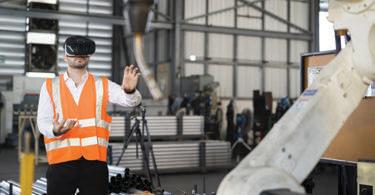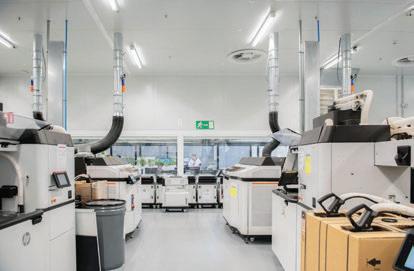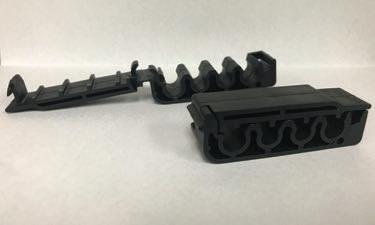
11 minute read
NEWS
Industrial Cybersecurity Concerns Heat Up in The Era of COVID-19
By David Miller
Senior Technical Writer, Automation World
As industrial companies connect plant-level software and devices to internet-connected enterprise systems, cybersecurity has become a critical operations issue for manufacturers of all sizes. While the Industrial Internet of Things (IIoT) greatly expands the efficiency of plant floor operations, it also introduces countless new vectors for potential cyberattacks. With more data flowing in and out of plants, the concern is that once localized networks will become more vulnerable.
The threat actors seeking to exploit these new loopholes include disgruntled employees and criminals attempting to steal intellectual property or other sensitive information for purposes of extortion, hacktivists who desire to garner public attention for their causes, and state-backed foreign agents engaged in espionage activities for political purposes.
Unfortunately, the risk of many of these types of attacks has only grown since the onset of COVID-19, according to cybersecurity company CrowdStrike’s recently released 2021 Global Threat Report. This increased hacking activity stems from several sources. For one, as lockdowns took hold in early 2020, many workers migrated to home offices that lacked the cybersecurity protections of commercial workplaces equipped with dedicated information technology (IT) staff. In addition, as remote access boomed, the potential attack surface available to hackers was broadened. Finally, fear and uncertainty surrounding the pandemic has increasingly been exploited to engage in phishing attacks and other forms of social engineering designed to trick users into granting malevolent actors access to proprietary systems and information.
CrowdStrike’s report details recent efforts engaged in by state-sponsored adversaries looking to steal valuable data pertaining to vaccine research and government responses to COVID-19 as well as targeted intrusions, sometimes referred to as “big game hunting.” In these latter efforts, e-criminals identify high-value individual targets for extortion and blackmail via infection with ransomware—software that locks users out of a system until a fee is paid. The report notes that ransomware attacks on manufacturing facilities have proven uniquely effective, as the time-sensitive nature of their production schedules often renders paying the fee less expensive than losing critical throughput.

Source: CrowdStrike’s 2021 Global Threat Report
CrowdStrike has observed a strong uptick in cybersecurity breaches in the past year. Manufacturing alone saw 228 ransomware incidents in 2020.
In addition to individual manufacturing facilities, healthcare and the supply chain also stood out in 2020 as particularly vulnerable. In the healthcare space, phishing attacks currently pose the greatest risk, with tactics and techniques taking a plethora of forms, including: exploitation of individuals looking for details on disease tracking, testing, and treatment; impersonation of medical bodies requesting information, including the World Health Organization (WHO) and U.S. Centers for Disease Control and Prevention (CDC); and offering financial assistance or government stimulus packages in exchange for private information.
Meanwhile, cyberattacks on the supply chain have relied on more sophisticated methods. For instance, in December of 2020, public reporting revealed a complex supply chain attack against the update deployment mechanism of the SolarWinds Orion IT management software. Those responsible for this attack were able to distribute malicious code which had the ability to collect information about the host, enumerate files and services on the system, modify registry keys, and terminate system processes. According to CrowdStrike’s report, supply chain attacks represent an especially pernicious tactic because they allow malicious actors to propagate their attack from a single point of intrusion to multiple downstream targets. Following from this, CrowdStrike identifies the securing of cloud environments as a priority for cybersecurity professionals in the years to come.
To chart ongoing threats, CrowdStrike has also created an eCrime index based on various observables which are weighted by impact and continuously monitored. The index will allow users to remain aware of the changing mechanisms and tactics used to exploit vulnerable systems and will include additional analysis provided by CrowdStrike’s subject matter experts. Watch this “Take Five with Automation World” video to fi nd out what industries are being targeted, who these e-criminals are, and how to protect your factory. View at awgo.to/1183.

XX Ultrasonic Sensors with NEW easy-to-use software. Ideal for level detection & control, mobile equipment, material handling and hoisting applications.

WOW! That was “Simply easy!”
This engineer just set up several ultrasonic sensors for a new machine line. Despite the varying ranges he had to set, he used a single software application. He set the distances. He adjusted gain. He filtered out anomalies. And those settings will remain for future replacement sensors.
Programmable... ...Flexible... ...and SMART!
Spatial Computing and Digital Twin Drive Interactive AR Simulations
By David Miller
Senior Technical Writer, Automation World
Wearable technologies and 5G wireless connectivity have long had an affinity for one another. Wearables can allow end-users to become walking, talking sensors capable of generating valuable data insights that can be used to improve workplace safety and ergonomics. In addition, augmented reality (AR), when paired with a wearable device, can grant field service professionals working in dangerous conditions access to hands-free schematics, instruction manuals, and even real-time audio-video feeds for remote assistance from distant subject matter experts. However, because harsh industrial conditions can often render the use of physical cabling difficult or impossible, the reliable wireless access provided by 5G has been indispensable to these technologies’ deployment in many fields.
In a similar vein, the deployment of digital twin simulations has also had a synergistic relationship with 5G, as its improved connectivity has enabled large quantities of data to be transmitted in real-time with minimal latency issues. Now, in the spirit of convergence that characterizes so much of Industry 4.0—5G wireless connectivity, AR, and digital twin simulations are becoming more closely connected as new spatial computing platforms emerge to grant workers and engineers immersive access to digital replicas of various environments.
For instance, PTC’s recently released Vuforia Engine Area Targets software—which is an extension of the company’s Vuforia AR enterprise platform—bills itself as the first piece of software on the market capable of creating fully immersive digital replicas of spaces up to 300,000 square feet in size. These digital twins set themselves apart from other CAD representations by allowing human workers to interact with them using AR interfaces to operate machinery virtually and better understand how the environment is being utilized for either training or workflow optimization purposes.
Area Targets builds its simulations by leveraging support from 3D scanner technology provided by software company Matteport and producer of geological survey instrumentation Leica 3D. In addition, an indoor mobile mapping system developed by spatial intelligence company NavVis is used to assist in generating reportedly photorealistic digital twins of spaces including factories, malls, offices, and other complex indoor environments.
Potential applications for Area Targets’ spatial computing capabilities include: optimizing various procedures within a given environment by acquiring a more complete picture of worker movements within the space over a period of time; providing data to machine learning algorithms to fuel spatial analytics that can improve performance; and gaining insight into how a physical space is used to make more informed design and layout decisions that enhance utilization, efficiency, and safety.

Ford and Nissan Use HP 3D Printing to Address Production Sustainability
By David Greenfield
Editor-In-Chief/Director of Content, Automation World
When you think about key computing technologies supporting advanced automation applications in manufacturing, Hewlett-Packard (HP) is not often the first technology supplier that comes to mind. After all, the company tends to be better known for its front office IT technologies. However, HP has been at the forefront of a number of advanced manufacturing applications on the plant floor for some time now. For example, Foxconn’s use of HPE Pointnext services to address quality assurance issues by deploying machine learning at the edge, and the introduction of the HP Metal Jet printer for high-volume manufacturing of production-grade metal parts.
Now, both Ford and Nissan have announced new sustainability programs enabled by HP 3D printing technology.
Ford is re-using spent 3D printed powders and parts and turning them into injection molded fuel-line clips for its Super Duty F-250 trucks. The automotive manufacturer
says this re-use of 3D printing materials is an industry first and that it has already identified 10 other fuel-line clips on other vehicles for which this process can be used.
Debbie Mielewski, Ford technical fellow, sustainability, said, “Many companies are finding great uses for 3D printing technologies, but, together with HP, we’re the first to find a highvalue application for waste powder that likely would have gone to a landfill by transforming it into functional and durable auto parts.”
Ford says that recycled materials from HP’s 3D have “better chemical and moisture resistance than conventional fuel-line clips, are 7% lighter, and cost 10% less.”
Nissan, Solize, and HP
At Nissan, HP’s 3D printing technology is being used in a joint effort by Solize Corp. and HP Inc. to design and manufacture 3D-printed replacement parts for Nissan’s NISMO (the motorsports and performance division of the Nissan Motor Company). HP’s
CONTINUES ON PAGE 22

HP 3D printers at Ford.
Innovative Automation Solutions
SENSORS: Inductive and Capacitive Proximity Sensors • Photoelectric Sensors • Level Sensors • Ultrasonic Sensors • Magnetic Sensors • Limit Switches • Interlocks SWITCHES: Solid State Relays • Contactors and Overloads • Soft Starters • Definite Purpose Contactors • Mini Circuit Breakers • Electromechanical Relays • Pilot Devices CONTROLS: Energy Meters and Software • Current-, Voltage- and 3-Phase Monitors • Current Transformers • Transducers • Time Delay Relays • Digital Panel Meters
CARLO GAVAZZI has the solution for your application needs, whether it’s our industry leading solid state relays, energy meters, contactors, motor controls, monitoring relays or sensors, now available with IO-Link communications.
Contact us today, and one of our field sales representatives will show you why we are one of the fastest growing automation companies worldwide. We’ll even provide a free evaluation sample to qualified customers. GavazziOnline.com • 847.465.6100 • Info@CarloGavazzi.com
Industry Ready For Safe Return of In-Person Trade Shows
By Sean Riley, Senior Director, Media and Industry Communications, PMMI
Registration is open for PACK EXPO Las Vegas and Healthcare Packaging EXPO (Sept. 27-29, Las Vegas Convention Center). After more than a year away from in-person trade shows, nearly nine out of ten packaging and processing end-users say in-person trade shows are essential for networking and discovering what is new in the industry, according to a recent poll from show producer PMMI, The Association for Packaging and Processing Technologies.
With respondents citing in-person trade shows as the most critical resource when choosing equipment, PACK EXPO Las Vegas and Healthcare Packaging EXPO is poised to be an unbeatable opportunity to connect with the industry and explore technology in action.
“This survey confirmed our belief that the industry relishes the unique opportunity to conduct business and see equipment in-person, with many noting that trade shows reveal solutions they were not considering before discovering them live,” says Laura Thompson, PMMI vice president, trade shows.
One survey respondent said that nothing could replace “being able to see and touch equipment while asking questions and receiving immediate feedback.” Another cited that the diverse array of exhibitors and education found at in-person events “make it a onestop-shop for investigating multiple solutions” for current projects as well as potential ideas on the horizon.
With its PACK Ready health and safety program, PACK EXPO Las Vegas and Healthcare Packaging EXPO will reunite the packaging and processing community, implementing thorough and up-to-date protocols for a safe and successful in-person event. Learn more at packexpolasvegas.com/packready.
PACK EXPO Las Vegas and Healthcare Packaging EXPO is the only show this year covering the entire packaging and processing industry with the latest new materials, technologies and solutions to address the packaging and processing needs of 40-plus vertical markets. With multiple free educational platforms and countless networking opportunities, the event will provide endless prospects for exchanging ideas and professional growth.
Industry partners continue to support the event as part of the PACK EXPO Las Vegas and Healthcare Packaging EXPO Partner Program, with 15 association partners already signed on to support and exhibit at the show, including the Association for Contract Packagers and Manufacturers (CPA), Institute of Packaging Professionals (IoPP), The Organization for Machine Automation and Control (OMAC), Flexible Packaging Association, Reusable Packaging Association, and more.
Early bird registration is $30, through Sept. 6 when the price goes up to $100. Visit packexpolasvegas.com/registration-info to secure a place at this vital industry event.
CONTINUED FROM PAGE 21
Multi Jet Fusion platform is used for production of these parts. The first part identified for restoration using 3D printing is a plastic part of the harness protector for the R32 Nissan Skyline GT-R (after an initial production run from 1969-1973, the Skyline GT-R was again produced from 1989-2002). The part is produced using HP High Reusability PA 11 which reportedly provides high mechanical properties and design flexibility.
This project represents a potential sea change for automotive manufacturers who have traditionally been required to provide replacement parts for their products over extended periods of time. As such, producing or storing parts for vehicles that have been discontinued, upgraded, or overhauled can be expensive, as manufacturers don’t retain molds for these parts or continue to manage inventory storage and logistics for them.
“We are seeing leaders of industry like Nissan recognize the massive cost implications of storage, molds, and logistics for replacement parts and how industrial 3D printing can help,” said Jon Wayne, head of global commercial business for 3D printing and digital manufacturing at HP Inc. “Digital manufacturing is a viable, long-term solution for accelerating production and transforming supply chains.”
Injection molded fuel-line clips for Ford’s Super Duty F-250 trucks made with used 3D printed powders and parts.






